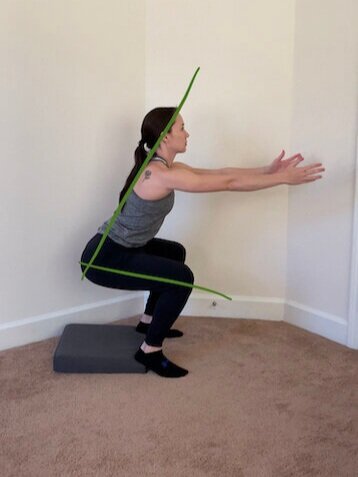Simplifying the Squat
The squat is a staple compound exercise that incorporates lower body muscles to produce the movement as well as abdominal and upper body muscle groups to stabilize and maintain posture. There are a variety of things such as muscle tightness and lack of adequate mobility that can impede your squat technique and lead you to injury. Exercise is meant to be helpful, not hurtful so it is important to notice these imbalances and implement modifications to allow you to safely and effectively perform this movement pattern. Let’s start off by going over proper squat form:
Begin with your feet under your hips and arms straight out in front of you. Lower into a squat position so that your knees are at 90 degrees and the tops of your thighs are parallel to the floor. When you are in this position your back should be straight from your head to your tailbone, your heels should be in contact with the ground, and your knees should be behind your toes. To return to the standing position, drive your feet through the floor and your hips forward to ensure you are using your leg muscles rather than your lower back. Tuck your pelvis and squeeze your glutes to avoid overarching your lower back.
Below are some come problems and corresponding solutions to encourage better technique.
IF your heels are lifting off the ground as you squat, add a wedge under your heels to reduce the ankle movement. You can use a foam pad, rolled up yoga mat, 1x4 board, or a pair of 5 lb weight plates.
IF your knees collapse inward at any point during the movement, use a mini loop band around your knees, just above or below your knee caps, to cue you to push your knees outward as you perform the exercise.
IF you are unable to maintain a straight line with your torso, use straps or a doorway for assistance. Using a chair or bench to sit back can also help cue you to shift your hips back as you are squatting. This could indicate that you have a lack of mobility in your thoracic spine and/or limited hamstring or hip flexor flexibility.
To progress from doorway or strap assisted squats, use a suspended resistance band for assistance. The band will still help keep your torso upright, but it will support less of your bodyweight. A band with lower resistance will result in a more challenging movement.
Once the loop band assisted squats become easy, you can move to an unsupported squat with a counterbalance. As you squat down slowly press a 5 - 10 lb weight out from your chest. This weight will counteract your bodyweight and allow you to sit your hips back and keep your torso upright.













